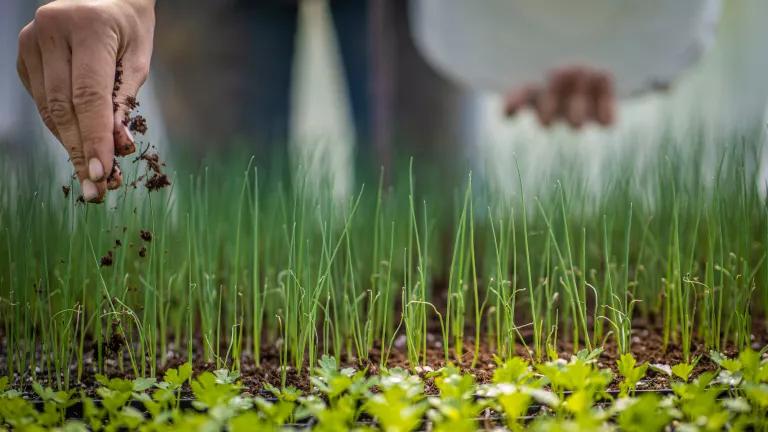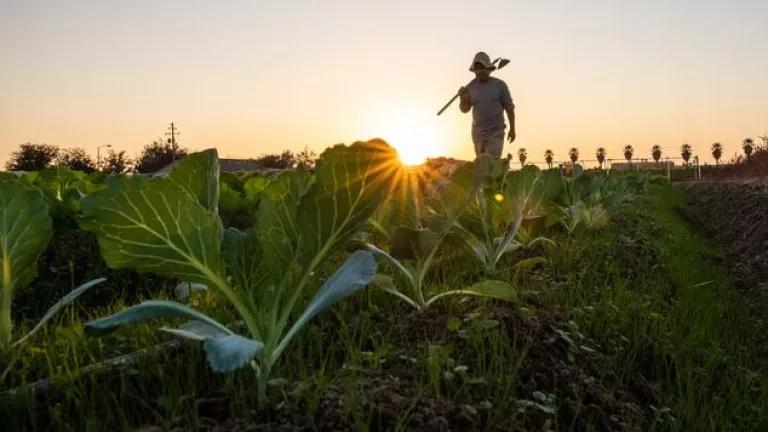California-Chile Water Nexus 2: Water-Smart Agriculture

This blog was co-written with Andrea Becerra (NRDC).
As water management experts show drought spreading in the western United States, predictions are placing the year 2020 among the 20 driest years in California. On the other side of the globe, Chile is in the midst of its own 11-year megadrought. The central part of the country, as in previous years, is expected to be the most impacted in the coming decades. In this context, NRDC and The Resilient Cities Office of the Metropolitan Regional Government of Chile kicked off the “The U.S–Chile Water Exchange” in February 2020. This series of webinars brings together water experts from NRDC in California and water experts working in Chile’s central region to share experiences working on water scarcity. This previous blog summarizes our first webinar on solutions to address drought in the urban sector.
Agriculture is Facing Water and Climate Insecurity
Agriculture is a powerhouse of an economic sector in both Chile and California, in terms of what it produces as well as consumes. In Chile, it amounts to 18.5 percent of Chilean exports and makes up nearly 85 percent of all water rights granted nationwide. In California, nearly 80 percent of human water use is geared towards agriculture, supplying the United States with over 30 percent of its vegetables and 66 percent of its fruits and nuts. The state also accounts for over 13 percent of the country’s agricultural value.
Unfortunately, the agriculture sector in both places is consuming water at an unsustainable rate given its dependence on greater quantities than what nature provides in the form of snow melt, groundwater aquifers, and precipitation. An estimated 20 aquifers in Chile’s Metropolitan Region are over-allocated, meaning the rights granted to people to pump groundwater exceed nature’s actual available water supply. California’s Department of Water Resources (DWR) has identified 21 groundwater basins and subbasins in which groundwater is used faster than is being replenished, resulting in significant “overdraft”. To aggravate matters, climate change is altering when and how much water is available around the globe, and for agriculture-rich economies like those found in California and Chile, this is especially relevant and concerning. The urgency to plan is greater than ever before.
Water Efficiency Means Climate Resilience
To meet future water needs, improving the efficiency with which agricultural producers use water now is a must. And it’s a win-win strategy. Water efficiency protects all users --from farmers to endangered species-- who depend on healthy ecosystems. Becoming more efficient helps farmers better withstand dry periods. Water efficiency also helps to improve water quality and can create new opportunities to conserve water for local ecosystems and to provide habitats for species. However, irrigation infrastructure, poor soil quality, and regulatory hurdles are three major barriers to making sector-wide progress in water efficiency in both California and Chile.
Irrigation infrastructure
How farms irrigate and when they irrigate are two of the most important questions to consider when tackling water efficiency.
A 2014 study by NRDC and the Pacific Institute found that California’s agricultural water use could be reduced by 5.6-6.6 million acre-feet per year (6.9-8.1 billion m3 per year), or 17-22 percent, while maintaining productivity and total acreage irrigated. These savings would come from the adoption of efficient irrigation technology, improved irrigation scheduling, and regulated deficit irrigation, which puts certain drought-tolerant crops under water stress, such as wine grapes and some nuts. When SouthSan Joaquín Irrigation District in California modernized its water system, farmers in this district were able to reduce both water and energy consumption by 30 percent as well as improve yields by 30 percent. This speaks to the power of investing in infrastructure, making the transition to modern farm applications more accessible.
Scheduling when to irrigate can also play a major role in reducing water use without compromising yields. Scheduling can be built around soil water content, meteorological data or monitoring plant stress. The greatest savings potential in California’s agriculture sector was associated with better irrigation scheduling: 2.7- 3.6 million acre-feet per year (3.3-4.4 billion m3 per year). Infrastructure plays a critical role in the adoption of irrigation scheduling. A study of 112 small-scale, irrigated farms in central Chile found that when pressurized irrigation like drip or sprinkler irrigation systems are implemented, scheduling is more likely to be adopted as well.
Poor Soil Quality
Farmers without access to more efficient irrigation or advanced technologies have another tool right at their feet: soil. Practices that promote soil health, like cover crops and no-till can improve soil infiltration and water retention capacity, combat water and nutrient loss, and prevent erosion. This regenerative model of farming is also a proven approach for saving money for farmers and growing rural economies by creating new jobs and providing millions of dollars worth of ecological services.
Dave Scott is a livestock specialist at the National Center for Appropriate Technology with over three decades of experience with intensive multi-paddock grazing in Montana. Since 2014, Dave and his wife, Jenny, have put a greater emphasis on soil health and letting soil microbes do their work. A 2016 drought put Montana Highland Lamb’s land to the test. After cutting back on irrigation in cooperation with the government’s request to irrigate less during the drought, he noticed that the grass on his paddock remained healthy. This event accomplished two things: first, he realized he could irrigate 25 percent less with no decrease in grass production -- transitioning from a daily irrigation schedule to a 10-day cycle -- and second, Dave realized that a healthier soil truly made his farm more resilient. The knowledge that in times of drought your land can withstand less water for irrigation is, as Dave puts it, “peace of mind for farmers.” And the answer has been lying right below the pick and shovel all along.
By focusing on soil health, Dave has also saved money. Healthier soil means reduced need for fertilizer, reduced labor in moving irrigation pipes, and improved pasture production, resulting in savings of $705 dollars per hectare. After decades of farming, one of the greatest lessons Dave draws from his experience in shifting to a soil health-focused system is that “the simple things take the longest time to understand.”

In Chile, 36.5 million hectares (48.7 percent of the country's territory) are considered eroded and 18.1 million hectares are categorized as “severely” or “very severely” eroded. Fully aware of the benefits of soil health, Chile’s federal government passed a law to subsidize agriculture practices that promote soil health in 2010. According to the government, poor soil is one of the “many obstacles that we currently face to reach the United Nations Sustainable Development Objective 2.” A recent publication by Austral University in Chile, posits that while regenerative farming practices have been increasingly adopted in small-scale farms, this practice has not permeated to most large-scale farmers -- the authors cite one reason for this as a lack of “ecological protocols” and locally tested results.
Creating Better Policy Tools
Better regulation and greater support to incentivize farmers to shift to new water-efficient practices can help build resilience for rural communities in the long-term. While individuals like Dave have taken it upon themselves to adopt new soil-health focused operations, shifting to new land management practices is not always a natural transition for farmers. For this reason a nudge to speed the shift to better soil management in both Chile and California is critical.
One example of a tool to improve soil management is through cover crop programs in the United States. Cover crops are planted in empty fields after the cash crop has been harvested to help keep living roots in the soil. The roots of cover crops like grasses and legumes provide important nutrients for beneficial soil organisms, and they also aerate the soil, which helps rain seep into the ground instead of escaping as runoff. Nevertheless, the adoption of cover crops is still low and only about 7 percent of U.S. farmland uses cover crops. NRDC is working to scale up cover cropping through innovative incentives delivered through crop insurance programs in Iowa and Illinois that give farmers who use cover crops $5/acre off of their crop insurance bill. (To learn about additional ways to advance soil conservation, read the “Guide to Building Healthy Soil.”)
In both Chile and California, a substantial portion of the agricultural sector relies on groundwater resources that are overallocated and overexploited. Both regions have attempted to address this through the creation of groundwater use associations. Under the Sustainable Groundwater Management Act (SGMA), passed in 2014, local and regional authorities in medium- and high-priority groundwater basins in California have formed groundwater sustainability agencies that oversee the preparation and implementation of a local groundwater sustainability plan. SGMA is California’s first attempt to regulate this resource--the state has relied heavily on groundwater for decades and a lack of regulation has led to over pumping its supply.
Similarly, in Chile, groundwater user associations (GWAs) have been set up across a few basins to push water users, including mining, farmers, and utilities, to work together to manage the resource more sustainably. However, the number of these associations that play an active role in managing groundwater is limited. The Catholic University of Chile and the University of Chile are working and studying the GWA in the Copiapó basin to understand the lessons learned from this experience as GWAs are implemented across the country.
While the legal framework for the creation of GWAs like the ones in Chile and California is a first step, a successful implementation is also dependent on the actual management of these associations. According to water management experts in Chile, a successful GWA “calls for dialogue and deliberation” involving the co-management of the resource by both state and users and a mutual understanding of stakeholders’ interests, concerns and preferences.
Looking forward
The agriculture sector is highly vulnerable to volatile water cycles but as a major water user it’s also one of the best places to start to improve water efficiency and build more resilient rural communities. To do so, policymakers need to incorporate these key elements into water plans:
- Address climate change. In order to mitigate future impacts of global warming on water resources, we need to cut greenhouse gas emissions from our energy, transportation, and agriculture sectors. Soil management is more than a tool to promote better yields and water management, it also has the added benefit of sequestering carbon -- in fact agriculture soils have the potential to sequester a whopping 250 million metric tons of carbon dioxide in the United States, which is equivalent to the annual emissions of 64 coal fired power plants.
- Invest in more modern irrigation infrastructure and implement creative finance mechanisms. Innovative green finance tools can serve an important role in both California and Chile.
- Create and ensure laws and policies support water conservation and support our ability to be better stewards and managers of this very important resource through initiatives like the cover crop program and the creation of well-managed groundwater user associations (GWAs).
- And finally, encourage soil health by providing technical assistance to farmers or helping farmers to switch to practice to improve soil health.




